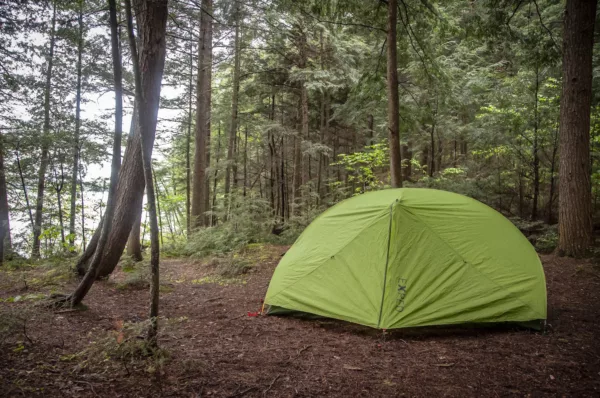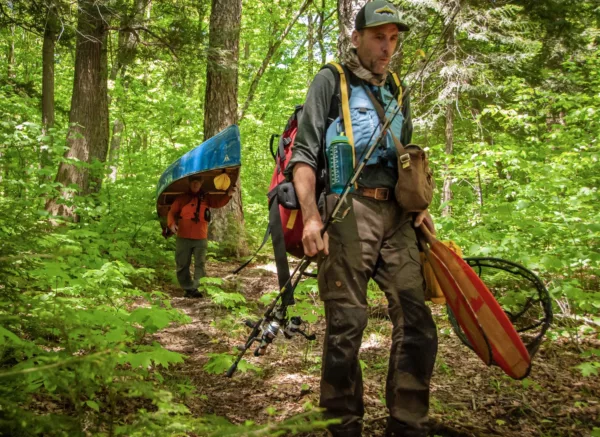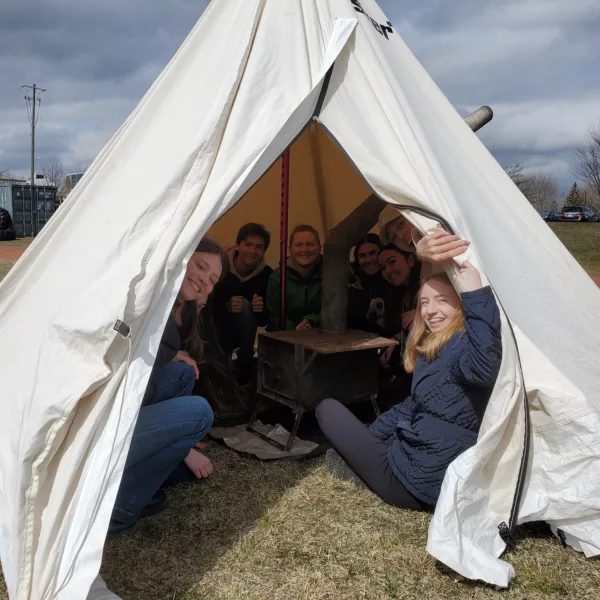The Way of the Wolf: Right Book, Right Time (8 perfect books to read while on an adventure)
All sorts of book lists come out at this time of year as people settle into soft couches over the holidays and dig into a good yarn. Over time, I’ve built up a list of my favourites—but with a twist.
These are books that I’ve read while out on a wilderness trip. They were curated to fit the spirit and aesthetic of the mission, something that paired well with the journey like wine with a meal. Therefore, I suggest you hold off from reading these tomes in your post-turkey tryptophan torpor. Wait until your next big adventure—these are meant to be read while in a tent or under the stars.
Here are the books, how I came upon them and the trips that I read them on:
In the Land of White Death
This was a fabulous book I randomly bumped into during a browse through the shelves of Pulp Fiction Books in Vancouver. In vivid detail, it tells the true story of the crew of a Russian whaling ship stuck for a year and a half in the sea ice north of 83 latitude in the early 1900s. Fearing they would never be freed, 14 of the crew—including author Valerian Albanov—decide to make a run for it over the endless expanse. One by one, the crew members meet their demise on a desperate death march to safety. It’s like a real-life horror movie—and like a horror movie, you’ll be on the edge of your seat, eyes peering through your fingers, unable to look away. I read this book during a 12-day, 160-kilometre ski trip on Bylot Island in the Canadian Arctic where we summited its highest peak, Angilaaq Mountain. The gripping narrative made our paltry journey seem like a spa retreat in comparison. Sometimes a gripping read really puts things into perspective.
People of the Deer
I picked up my battered copy of this Farley Mowatt classic for a buck down at Powell’s Books in Portland, Oregon. Published in 1951, it recounts Mowatt’s time as a field researcher working along the Kazan River and his experience living with the last few Caribou Inuit that lived in the region before they were moved to coastal towns for good a few years later. Many have accused the book of being part fiction, but his descriptions of the land, the animals and the people are undeniable. I read this while on a 2,000-kilometre canoe journey through the barren grounds from Yellowknife to Rankin Inlet with my friend Taku. Though that trip took place largely on the Thelon River, Mowatt’s descriptions of life in the barrens of the Kazan were a perfect accompaniment to our trip—particularly when we ran into a herd of a couple of thousand caribou (‘deer’) partway along the river. The book left such an impression that I paddled the length of the Kazan River seven years later in the course of a journey from La Ronge to Baker Lake.
The Orenda
I didn’t choose this book to read on trip—it chose me. While on a 1,750-kilometre canoe trip from Yellowknife to Chantry Inlet this past summer, my friend Ryan Bougie and I came across a lone cabin in the Barrens that had been ransacked by a grizzly. It was hard to tell how long it had been since a person had visited the cabin as everything was strewn about in various broken states. Seemingly untouched in the corner was a copy of Joseph Boyden’s novel The Orenda. I’d been dissatisfied with my choice of George Orwell’s Animal Farm as a trip book, so did a book exchange right there and then. For the rest of the journey, The Orenda had me gripped. This tale of Huron and Iroquois combatants in the very early days of colonization made me constantly reflect on the dynamic and vibrant indigenous societies that used to exist not only in Eastern Canada where the story is set, but in all corners of the country. It particularly made me appreciate the wild, wonderful country along the Back River that was too remote for colonists to ever lay a hand on—remaining largely unchanged to this day.
The Golden Spruce
In 2005, I did a 900-kilometre sea kayak circumnavigation of the Haida Gwaii archipelago with my friends Todd Macfie and Keith Klapstein. A week before we left, The Golden Spruce by John Vaillant was released, and Todd was gifted the book by a friend to read on the journey. Set largely in Haida Gwaii, each of us got a crack at it during our 43-day odyssey around those mythical islands. The true tale of disillusioned former logger Grant Hadwin, who cut down an ancient golden spruce as a protest to the hypocrisy of the logging industry, reads like a thriller. Mixed in with the story of Hadwin is the history of logging on the West Coast, with a particularly jarring chapter that describes in detail some of the gory injuries that have taken place in that most dangerous of professions. Kayaking the outer coast of Haida Gwaii was like falling asleep in a rocking chair compared to the life of a tree feller. Again, good perspective.
Cache Lake Country
This book was another find in a Vancouver used book store—this time, The Paper Hound on the edge of the Downtown Eastside. A great shop for odd and rare finds, this copy of Cache Lake Country was signed ‘To Bob: Hope this inspires your future adventures. Happy Birthday, Dad. July 5th, 1965.’ The book was written by John J. Rowlands based on his experiences in the northern Temagami Region from 1911 to 1916. Set over 12 months, this quiet narrative about a simple life in the woods is also chock-a-block full of traditional skills he largely learned from his Cree elder friend Chief Tibeash. It was the perfect book for a big canoe loop I did through the north of the Temagami Region a few years ago.
The Monkey Wrench Gang
I think at some level all people who spend their passionate time in the outdoors have a rebellious streak. We don’t like being told what to do and love the freedom that living out in the open provides. That’s what Edward Abbey’s The Monkey Wrench Gang is all about. A ragtag band of four fringe members of society take protecting the desert wilderness of Utah and Arizona into their own hands through ‘direct action’ tactics on the infrastructure of the enemies of their beloved desert wilderness. The book is at times hilarious, sometimes sobering, but always entertaining. I picked up my copy at an estate sale of some former hippies when I was passing through California’s Russian River Valley earlier that year. They had bought the place in the 60s for nothing and were cashing out. All remnants of their former lives were up for grabs, so I grabbed that book along with some sweet vintage vinyl. I read it during a week-long pack rafting and hiking trip through ‘The Maze’ in Utah’s Canyonlands National Park. The Maze also happens to be where one of the penultimate showdowns between the authorities and the rebel heroes of the book takes place, so a lovely relevance to the read.
Sleeping Island
An acquaintance of mine heard I was going to paddle through Northern Saskatchewan in the course of an 1800-kilometre canoe trip up to Baker Lake in 2016. He said, “You have to pick up Sleeping Island.” I’d never heard of the book but hunted it down and it turned out to be the perfect fit for the first leg of that journey. The author, P.G. Downes, was a teacher in Boston during the 1930s. Every summer, he’d go up to Northern Saskatchewan to travel and explore the area by canoe, linking up with Indigenous and other local people as partners. The route recounted in the book paralleled much of ours and it was fascinating to compare what he encountered. Ironically, there were a lot more people spending time on the land back then as Downes met Chipewyan people (now called Dene) all along the route hunting and fishing in nomadic camps as they had for centuries. That way of life no longer exists as people now remain largely cloistered in the comfort of towns like Lac Brochet—our only stop along a 44-day route.
With Dersu the Hunter
This little-known work is a gem—and perhaps my favourite book ever. It was written by a Russian surveyor who explored then-unknown Siberia in the early 1900s. Over the course of several years he befriended Dersu, an indigenous hunter who showed him how to survive and thrive in the harsh hinterland there. The book reveals how in tune with the land people once were, using skills we’ve now largely lost. I read this book on a 1,050-kilometre canoe journey in Ontario’s ‘Little North’ in 2011 with my friend Todd McGowan. Our route took us from Pakashkan Lake, down the Brightsand River, through all of Wabakimi and down the Winisk River to the village of Peawanuck. Moving through this roadless boreal splendor, I felt like I was right there with Dersu, at ease and comfort in a place far from the madness of civilization.
Happy Reading!
Frank Wolf’s book LINES ON A MAP was released in Fall 2018 by RMB















